Discover the amazing world of wildlife and their unique diets and feeding habits. From the eucalyptus-munching koalas to the opportunistic Arctic wolves, these animals have adapted to their diverse habitats in remarkable ways.
Understanding the dietary needs and preferences of these creatures is crucial for their conservation and management. However, with so many different species and ecosystems to consider, it can be challenging to grasp the complexities of their feeding behaviours.
In this comprehensive guide, we’ll explore the diets and feeding habits of a wide range of animals, including marsupials like wombats, wallabies, and Tasmanian devils, as well as non-marsupials such as sugar gliders and bandicoots.
Herbivorous
Herbivorous animals are those that primarily feed on plants, including leaves, fruits, seeds, and even bark. These animals have adapted to extract nutrients from plant materials, which are often high in fiber and low in calories compared to animal tissue.
Herbivores play a crucial role in their ecosystems by controlling plant growth, dispersing seeds, and serving as prey for carnivores. Some examples of herbivorous animals include koalas, kangaroos, and wombats, each with their unique adaptations for a plant-based diet.
Wombats
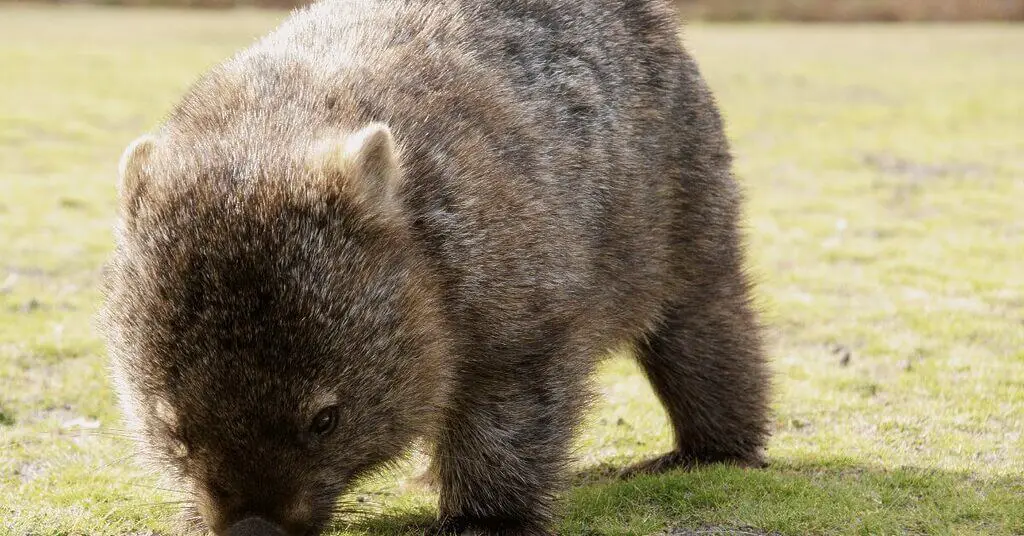
Wombats are herbivorous marsupials native to Australia. They have a unique diet that primarily consists of grasses, sedges, and roots. Wombats are known to consume large amounts of vegetation, often eating up to 1/3 of their body weight in a single day.
To learn more about the specific types of plants that wombats eat, check out this article.
Wombats have several adaptations that allow them to thrive on a herbivorous diet:
- Strong, continuously growing teeth: Wombats have powerful teeth that grow throughout their lives, enabling them to grind down tough plant material.
- Specialized digestive system: Their digestive tract is designed to extract maximum nutrients from fibrous plants, with a long cecum that helps break down cellulose.
- Low metabolic rate: Wombats have a low metabolic rate, which allows them to conserve energy and survive on a low-calorie diet of plants.
These adaptations have enabled wombats to become successful herbivores in their native Australian habitats.
Wallabies
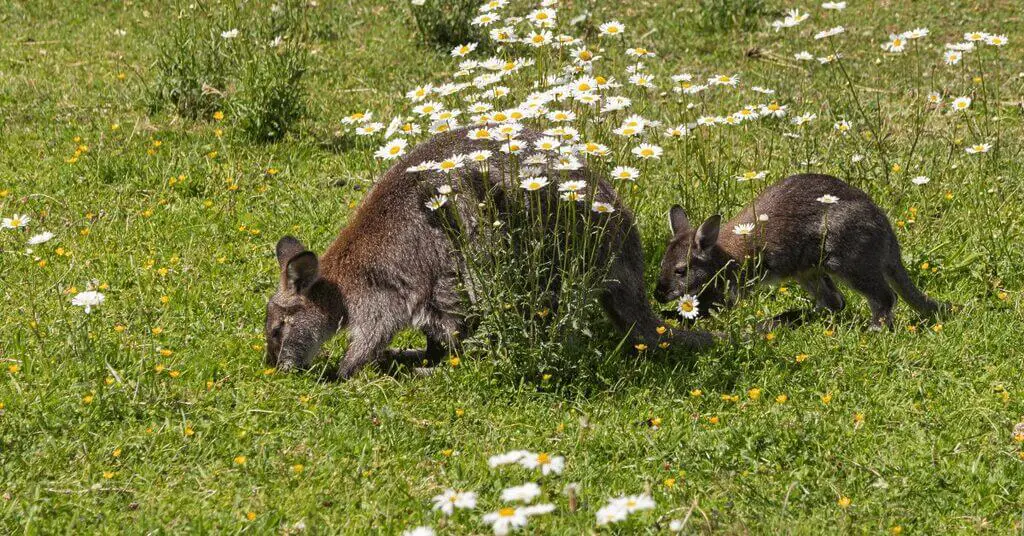
Wallabies are medium-sized marsupials native to Australia, and they have a diet that primarily consists of plants. As herbivores, wallabies play a crucial role in their ecosystem by maintaining plant diversity and serving as prey for other animals.
Their diet includes a variety of grasses, herbs, leaves, and shrubs. The specific types of plants consumed by wallabies can vary depending on the species and their habitat.
There are several different species of wallabies, each with their own unique dietary preferences. Some common types of wallabies and their diets include:
- Red-necked wallabies: These wallabies primarily feed on grasses, herbs, and leaves.
- Swamp wallabies: As their name suggests, swamp wallabies are often found in wet, marshy areas and consume plants such as sedges, ferns, and shrubs.
- Rock wallabies: These wallabies live in rocky areas and eat grasses, herbs, and leaves that grow in these environments.
To learn more about the specific diets of different wallaby species, check out this article.
Wallabies have several adaptations that allow them to thrive on a plant-based diet:
- Specialized teeth: Wallabies have teeth that are well-suited for grinding down tough plant material, with sharp incisors for cutting and strong molars for chewing.
- Efficient digestive system: Their digestive tract is designed to extract maximum nutrients from fibrous plants, with a large stomach and a long intestine that helps break down cellulose.
- Bacterial fermentation: Wallabies have bacteria in their digestive system that help ferment plant material, making it easier to digest and extract nutrients.
These adaptations enable wallabies to efficiently process and derive energy from the plants they consume, making them well-suited to their herbivorous lifestyle.
Quokkas
Quokkas are small, herbivorous marsupials found primarily on the Australian island of Rottnest and in a few other areas of Western Australia. These cute and friendly animals have a unique diet and play an important role in their ecosystem.
Their diet mainly consists of grasses, leaves, and stems. They are also known to eat some types of flowers and seeds. Quokkas have a special digestive system that helps them break down tough plant material and extract the nutrients they need.
They play a significant role in maintaining the balance of their ecosystem. As herbivores, they help control plant growth by eating grasses and other vegetation. This prevents the overgrowth of certain plant species and maintains biodiversity.
Additionally, quokkas serve as prey for some predators, such as birds of prey and dingoes. By being a part of the food chain, they contribute to the overall health and stability of their ecosystem.
Quokkas also have an impact on their environment through their droppings. Their waste acts as a natural fertilizer, providing nutrients to the soil and supporting plant growth.
To learn more about what quokkas eat and their feeding habits, check out this article: What Do Quokkas Eat?
Kangaroos
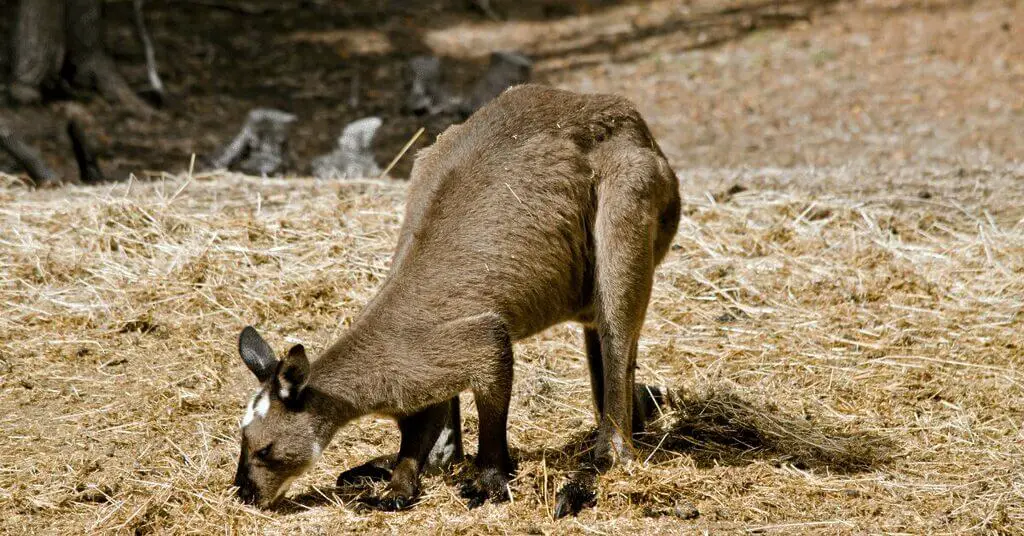
Kangaroos are iconic Australian marsupials known for their powerful hind legs and unique hopping movement. As herbivores, they have a specialized diet that primarily consists of grass, leaves, and tree bark. There are four main species of kangaroos, each with slightly different dietary preferences:
- Red kangaroos mainly feed on grass but will also eat leaves, herbs, and shrubs when grass is scarce.
- Eastern grey kangaroos primarily consume grass, leaves, and tree bark.
- Western grey kangaroos have a similar diet to eastern grey kangaroos, focusing on grass, leaves, and tree bark.
- Antilopine kangaroos, found in northern Australia, eat a variety of grasses and other vegetation.
Check out this page on kangaroo diets to learn more. Kangaroos have several adaptations that allow them to efficiently process and digest plant material:
- Specialized teeth: They have sharp front teeth for cutting grass and powerful molars for grinding tough plant fibers.
- Large stomach: Kangaroos have a large, chambered stomach that helps break down plant material with the help of bacteria.
- Long intestines: Their long intestines enable them to extract maximum nutrients from fibrous plants.
- Regurgitation and re-chewing: Kangaroos often regurgitate their food and chew it again to further break down plant fibers and improve digestion.
These adaptations have allowed kangaroos to become successful herbivores in the Australian landscape, where they play a crucial role in maintaining the balance of their ecosystems.
Koalas
Koalas are iconic Australian marsupials known for their cute appearance and unique diet. They are found in the eucalyptus forests of eastern Australia, where they spend most of their time in trees.
Koalas have a highly specialized diet, feeding almost exclusively on eucalyptus leaves from around 30 different species of eucalyptus trees. This diet is low in nutrients and calories, but koalas have evolved several adaptations to help them survive on this food source.
Check out this article for more information on Koalas’ dietary habits.
Koalas have developed several adaptations to help them process and digest their eucalyptus diet:
- Special digestive system: Koalas have a long pouch-like structure in their digestive tract that contains bacteria to help break down the tough eucalyptus leaves.
- Efficient liver: The koala’s liver is very good at removing the harmful substances found in eucalyptus leaves.
- Low metabolic rate: Koalas have a very low metabolic rate, which helps them save energy and survive on their low-nutrient diet.
- Strong jaws and teeth: Koalas have strong jaws and sharp cheek teeth that allow them to grind the tough eucalyptus leaves.
Despite living high up in trees and being relatively large, koalas do have some predators. To learn more about the animals that hunt koalas, visit What Eats Koalas?
Omnivorous
Omnivorous animals are those that have a diverse diet consisting of both plant and animal matter. They have adapted to consume a wide range of food sources, which allows them to survive in various habitats and environments.
Omnivores have digestive systems that can process both plant material, such as fruits, leaves, and seeds, as well as animal protein, including insects, eggs, and meat. This dietary flexibility gives omnivores an advantage in terms of finding food, as they can adapt to seasonal changes and food availability. Some examples of omnivorous animals include bears, pigs, and humans.
Opossums
Opossums are opportunistic omnivores native to North and South America. They are known for their adaptability and diverse diet, which includes a wide variety of plant and animal matter. Opossums are scavengers and will eat almost anything they can find, including fruits, vegetables, insects, small mammals, birds, eggs, and even carrion.
Visit What Do Opossums Eat to learn more about what they eat. Moreover, Opossums have several adaptations that allow them to thrive on their varied diet:
- Flexible and dexterous front paws: Opossums have opposable “thumbs” on their hind feet and flexible front paws that help them grasp and manipulate food items.
- Strong sense of smell: They have a keen sense of smell that helps them locate food sources, even when hidden or buried.
- Sharp teeth: Opossums have 50 sharp teeth, more than any other North American mammal, which enables them to eat a wide range of foods, including tough or hard items.
- Efficient digestive system: Their digestive system is adapted to process a variety of food types, extracting nutrients from both plant and animal matter.
These adaptations, combined with their opportunistic feeding habits, have allowed opossums to become successful omnivores and survive in a wide range of habitats across the Americas.
Sugar Gliders
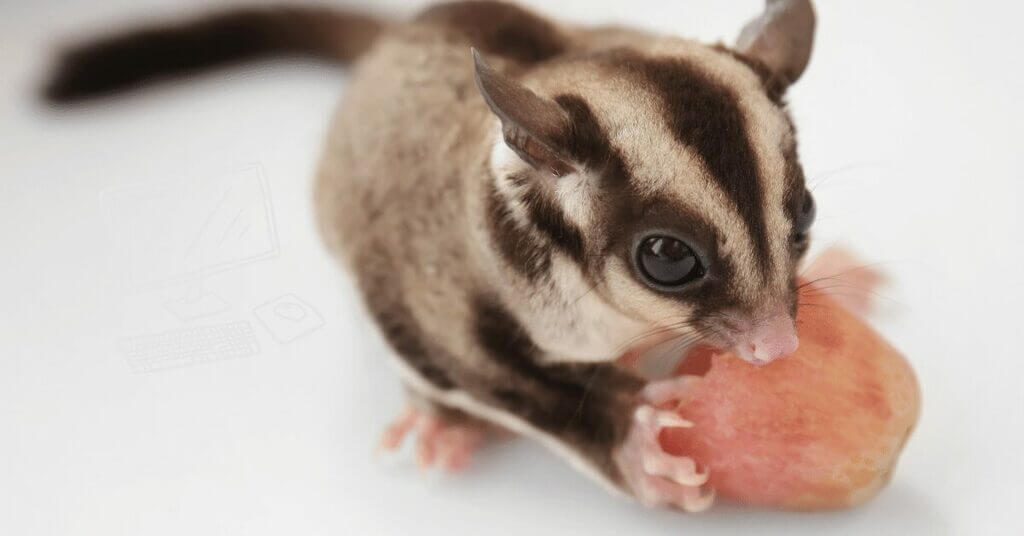
Sugar gliders are small, omnivorous marsupials native to Australia, Indonesia, and Papua New Guinea. These cute, furry creatures are known for their ability to glide through the air using a membrane that stretches from their wrists to their ankles.
In the wild, sugar gliders feed on a variety of foods, including sap, nectar, pollen, insects, and small vertebrates. Find out more about the sugar glider diet in this article.
Sugar gliders have several adaptations that enable them to thrive on their omnivorous diet and arboreal lifestyle:
- Long, sticky tongue: Sugar gliders have a long, sticky tongue that helps them lap up nectar and sap from trees and collect pollen from flowers.
- Sharp teeth: They have sharp, pointed teeth that are well-suited for catching and eating insects and small vertebrates.
- Gut adaptations: Sugar gliders have a specialized digestive system that allows them to extract nutrients from both plant and animal matter efficiently.
- Gliding membrane: The gliding membrane, called a patagium, allows sugar gliders to glide from tree to tree in search of food, covering distances of up to 50 meters in a single glide.
- Grippy hands and feet: Sugar gliders have strong, sharp claws and opposable thumbs on their hind feet, which help them grasp branches and move easily through the treetops.
These adaptations have allowed sugar gliders to become successful omnivores and thrive in their arboreal habitats, making them well-suited to their life in the trees.
Bandicoots
Bandicoots are small, omnivorous marsupials native to Australia and New Guinea. These nocturnal animals have a diverse diet that includes both plant and animal matter, which they forage for using their keen sense of smell and hearing.
In the wild, bandicoots play an important role in their ecosystems by helping to disperse seeds and control insect populations.
Pet bandicoots have specific dietary needs and nutrition needs. Learn more about what I feed my pet bandicoot.
Bandicoot feeding habits in the wild:
- Omnivorous diet: Wild bandicoots eat a variety of foods, including insects, earthworms, small vertebrates, fruits, seeds, and fungi.
- Foraging behavior: They use their strong claws to dig for food in the soil, often leaving distinctive conical holes in the ground.
- Seasonal variations: Bandicoot diets may vary depending on the season and the availability of different food sources.
Bandicoot feeding habits in captivity:
- Balanced diet: Pet bandicoots require a well-balanced diet that mimics their natural feeding habits, including a mix of commercial insectivore diet, fruits, vegetables, and live insects.
- Freshwater: It is important to provide pet bandicoots with a constant supply of fresh, clean water.
By understanding the dietary needs and feeding habits of bandicoots in both the wild and captivity, we can ensure that these unique marsupials receive the proper nutrition to thrive.
Carnivorous
Carnivorous animals are those that primarily feed on other animals for their sustenance. They have evolved to hunt, catch, and consume prey, which provides them with the necessary nutrients, such as protein and fat, for growth and survival.
Carnivores have specific adaptations that enable them to be effective predators, including sharp teeth and claws, strong jaws, and keen senses of sight, hearing, and smell.
Some carnivores are obligate carnivores, meaning they rely solely on animal tissue for their nutritional needs, while others are facultative carnivores, which can supplement their diet with plant matter when prey is scarce. Examples of carnivorous animals include cats, wolves, and many species of birds, reptiles, and fish.
Tasmanian Devils
Tasmanian devils are carnivorous marsupials endemic to the island state of Tasmania, Australia. These small but feisty creatures are known for their powerful jaws, loud screeching sounds, and unique feeding habits. Tasmanian devils are opportunistic predators and scavengers, feeding on a variety of prey and carrion.
Tasmanian devil diet:
- Carnivorous: Tasmanian devils are strictly carnivorous, with a diet consisting mainly of small to medium-sized mammals, birds, and reptiles.
- Favorite foods: They are particularly fond of wombats, wallabies, and possums, but they will also eat insects, fish, and even dead animals.
- Powerful jaws: Tasmanian devils have incredibly strong jaws and sharp teeth, allowing them to crush bones and tear apart tough meat.
Scavenging behavior and role in the ecosystem:
- Scavengers: In addition to hunting live prey, Tasmanian devils are also efficient scavengers, often feeding on carrion left behind by other predators or animals that have died from other causes.
- Disease control: By consuming carrion, Tasmanian devils help prevent the spread of diseases in their ecosystem, as they remove decaying animals that could harbor harmful bacteria and parasites.
- Nutrient cycling: Tasmanian devils play a crucial role in nutrient cycling within their habitat by breaking down and distributing nutrients from their prey throughout the ecosystem.
The unique feeding habits and scavenging behavior of Tasmanian devils make them an integral part of the Tasmanian ecosystem, helping to maintain balance and promote the overall health of their habitat. Read What Is a Tasmanian Devil’s Favorite Food? to learn more.
Arctic Wolves
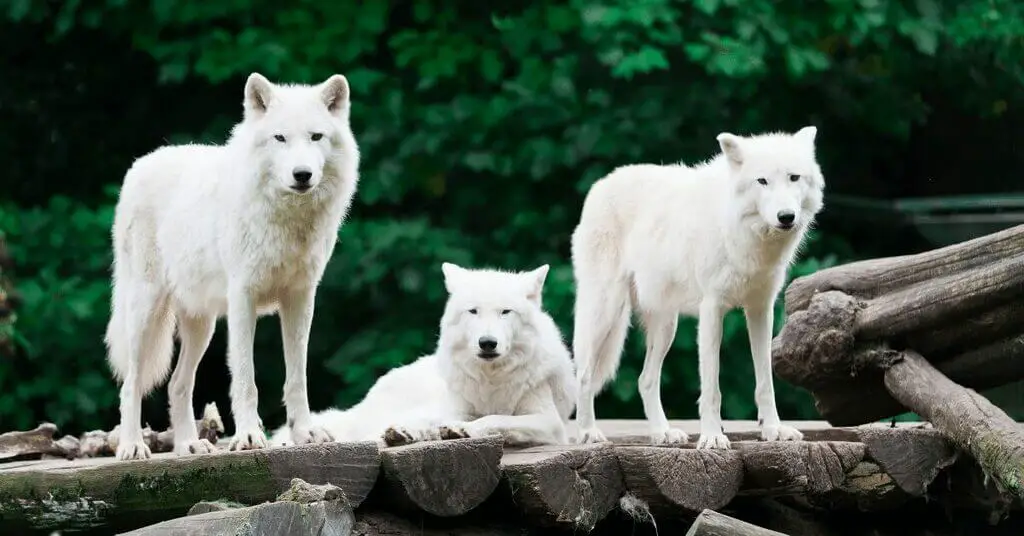
Arctic wolves, also known as white wolves or polar wolves, are a subspecies of grey wolf native to the Arctic regions of North America and Greenland.
These majestic creatures are well-adapted to the harsh, cold environment of the tundra, with thick, white fur that provides excellent insulation and camouflage. As carnivores, Arctic wolves rely on a diet consisting mainly of large prey animals.
Arctic wolf diet and hunting habits:
- Primary prey: Arctic wolves primarily hunt muskoxen and caribou, which provide them with the necessary nutrients and energy to survive in the cold, barren tundra.
- Hunting strategy: These wolves are known for their incredible endurance, as they often travel long distances in search of prey. They hunt in packs, using teamwork to take down large animals.
- Opportunistic feeding: In addition to their primary prey, Arctic wolves will also consume smaller mammals, such as arctic hares and lemmings, as well as birds and fish when available.
Adaptations for carnivorous diet and arctic environment:
- Powerful jaws and teeth: Arctic wolves have strong jaws and sharp teeth that enable them to bring down large prey and tear through tough hide and meat.
- Keen senses: They have excellent hearing, sight, and smell, which help them locate prey and navigate their environment.
- Thick, insulating fur: Arctic wolves have a dense, white fur coat that keeps them warm in the freezing temperatures of the tundra and also serves as camouflage against the snow.
- Large, padded paws: Their large, furry paws help them traverse snow and ice efficiently, acting as natural snowshoes.
These adaptations, combined with their skilled hunting abilities, allow Arctic wolves to thrive as top predators in one of the harshest environments on Earth. Read this article to find out what Arctic wolves eat and how they hunt.
Conclusion
The diverse range of Australian and Arctic wildlife showcases a fascinating array of diets and feeding habits. From herbivorous marsupials like wombats, wallabies, and koalas to omnivorous opossums, sugar gliders, and bandicoots, these animals have evolved unique adaptations to thrive on their specific diets.
The carnivorous Tasmanian devils and Arctic wolves, on the other hand, have developed powerful jaws, sharp teeth, and keen senses to hunt and consume their prey effectively.
Each species plays a crucial role in its respective ecosystem, whether by controlling plant growth, dispersing seeds, or maintaining balance through predation and scavenging.
By understanding the dietary needs and feeding habits of these remarkable animals, we gain a deeper appreciation of their adaptations and habitat roles.

